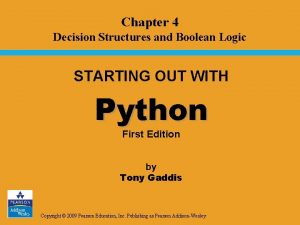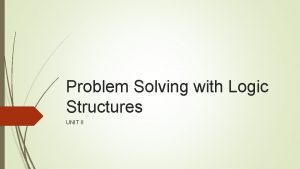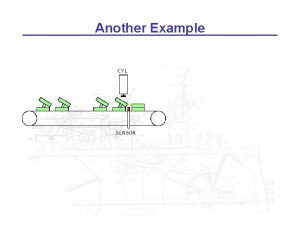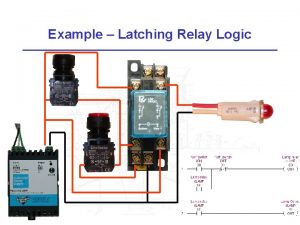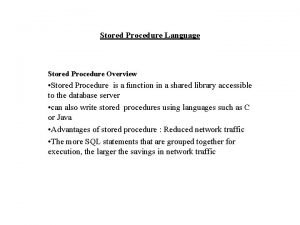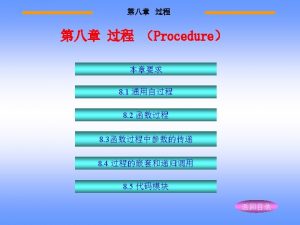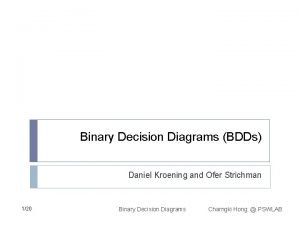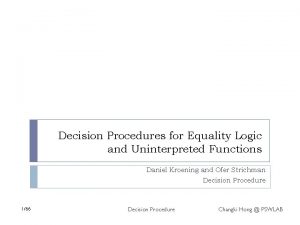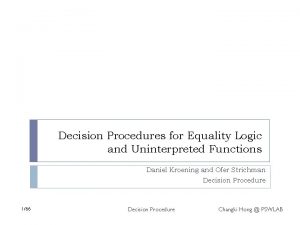Yet another decision procedure for Equality Logic Ofer









































- Slides: 41

(Yet another) decision procedure for Equality Logic Ofer Strichman and Orly Meir Technion 1

Equality Logic n E: 0 0 0 1 (x 1 = x 2 Æ (x 2 = x 3 Ç x 1 x 3)) n Domain: x 1, x 2, x 3 2 N n The satisfiability problem: is there an assignment to x 1, x 2, x 3 that satisfies E ? n Q: When is Equality Logic useful ? . . . Technion 2

Equality Logic 0 0 0 1 n E: (x 1 = x 2 Æ (x 2 = x 3 Ç x 1 x 3)) n A: Mainly when combined with Uninterpreted Functions f(x, y), g(z), … n Mainly used in proving equivalences, but not only. Technion 3

Basic notions E: x = y Æ y = z Æ z x (non-polar) Equality Graph: y x z Gives an abstract view of E Technion 4

From Equality to Propositional Logic E : x 1 = x 2 Æ x 2 = x 3 Æ x 1 x 3 B: e 1, 2 Æ e 2, 3 Æ : e 1, 3 x 1 e 1 , 2 e 1, 3 Bryant & Velev CAV’ 00 – the Sparse method x 2 e 2, 3 x 3 n Encode all edges with Boolean variables ¨ This is an abstraction ¨ Transitivity of equality is lost! ¨ Must add transitivity constraints! Technion 5

From Equality to Propositional Logic E : x 1 = x 2 Æ x 2 = x 3 Æ x 1 x 3 B: e 1, 2 Æ e 2, 3 Æ : e 1, 3 x 1 e 1 , 2 e 1, 3 Bryant & Velev CAV’ 00 – the Sparse method x 2 e 2, 3 x 3 n Transitivity Constraints: For each cycle of size n, forbid a true assignment to n-1 edges T S = (e 1, 2 Æ e 2, 3 ! e 1, 3) Æ (e 1, 2 Æ e 1, 3 ! e 2, 3) Æ (e 1, 3 Æ e 2, 3 ! e 1, 2) Check: B Æ T S Technion 6

From Equality to Propositional Logic Bryant & Velev CAV’ 00 – the Sparse method n Thm-1: It is sufficient to constrain simple cycles only T e 2 T T e 3 e 4 F e 1 e 6 T e 5 T Technion 7

From Equality to Propositional Logic Bryant & Velev CAV’ 00 – the Sparse method n Thm-2: It is sufficient to constrain chord-free simple cycles T e 2 T e 5 F e 1 T F e 3 T e 4 Technion 8

From Equality to Propositional Logic Bryant & Velev CAV’ 00 – the Sparse method n Still, there can be an exponential number of chordfree simple cycles… …. n Solution: make the graph ‘chordal’! Technion 9

From Equality to Propositional Logic Bryant & Velev CAV’ 00 – the Sparse method n Dfn: A graph is chordal iff every cycle of size 4 or more has a chord. n How to make a graph chordal ? eliminate vertices one at a time, and connect their neighbors. Technion 10

From Equality to Propositional Logic Bryant & Velev CAV’ 00 – the Sparse method n In a chordal graph, it is sufficient to constrain only triangles. T T Contradiction! T T F T T n Polynomial # of edges and constraints. n # constraints = 3 £ #triangles Technion 11

An improvement Reduced Transitivity Constraints (RTC) n So far we did not consider the polarity of the edges. E: x = y Æ y = z Æ z x n Assuming E is in Negation Normal Form y (polar) Equality Graph: x = = Technion z 12

Monotonicity of NNF n Thm-3: NNF formulas are monotonically satisfied (in CNF this is simply the pure literal rule) n Let be in NNF and satisfiable. Thm-3 implies: ¨ Let ² ’ from by switching the value of a ‘mis-assigned’ pure literal in ¨ Derive ¨ Now ’ ² Technion 13

An improvement Reduced Transitivity Constraints (RTC) n Claim: in the following graph T sufficient R = e 3 Æ e 2 ! e 1 is z e 1 Allowing e. g. e 1 = e 2 = T, e 3= F = e 3 = x n e 2 y This is only true because of monotonicity of NNF (an extension of the pure literal rule) Technion 14

Basic notions y x z n Equality Path: a path made of equalities. we write x =*z n Disequality Path: a path made of equalities and exactly one disequality. We write x *y n Contradictory Cycle: two nodes x and y, s. t. x=*y and x * y form a contradictory cycle Technion 17

Basic notions n Thm-4: Every contradictory cycle is either simple or contains a simple contradictory cycle Technion 18

Definitions n Dfn: A contradictory Cycle C is constrained under T if T does not allow this assignment T T C= T T F Technion 19

Main theorem n If T R constrains all simple contradictory cycles, and S S For every assignment , ² T n S! S ²TR From the Sparse method then E is satisfiable iff B Æ T R is satisfiable The Equality Formula Technion 21

Proof of the main theorem n ( ) E is satisfiable BÆT S is satisfiable BÆT R is satisfiable n ( ) Proof strategy: R be a satisfying assignment to B Æ T R ¨ We will construct S that satisfies B Æ T S ¨ From this we will conclude that E is satisfiable ¨ Let Skip proof Technion 22

Definitions for the proof… n A Violating cycle under an assignment R: F e. T 1 T Either dashed or solid T e. T 2 n This assignment violates T S but not necessarily T R Technion 23

More definitions for the proof… n An edge e = (vi, vj) is equal under an assignment iff there is an equality path between vi and vj all assigned T under . Denote: v 3 F v 1 T Technion T v 2 24

More definitions for the proof… n An edge e = (vi, vj) is disequal under an assignment iff there is a disequality path between vi and vj in which the solid edge is the only one assigned false by . Denote: v 3 F v 1 T Technion T v 2 25

Proof… n Observation 1: The combination is impossible if = R (recall: R ² T R) v 3 F T v 1 n T v 2 Observation 2: if (v 1, v 3) is solid, then Technion 26

Re. Constructing S Type 1: Type 2: It is not the case that Otherwise it is not the case that v 3 F F T T v 1 n T v 1 v 2 Assign S (e 23) = F n v 2 Assign (e 13) = T In all other cases S = R Technion 27

Re. Constructing S n Starting from R, repeat until convergence: (e. T) : = F in all Type 1 cycles ¨ (e. F) : = T in all Type 2 cycles ¨ n All Type 1 and Type 2 triangles now satisfy T S n B is still satisfied (monotonicity of NNF) n Left to prove: all contradictory cycles are still satisfied Technion 28

Proof… n Invariant: contradictory cycles are not violating throughout the reconstruction. T v 3 F T T v 1 n v 2 contradicts the precondition to make this assignment… Technion 29

Proof… n Invariant: contradictory cycles are not violating throughout the reconstruction. v 3 F T T F v 1 n v 2 contradicts the precondition to make this assignment… Technion 30

Applying RTC n How can we use theorem without enumerating contradictory cycles ? n Answer: ¨ Consider the chordal graph. ¨ Constrain triangles if they are part of a (simple) contradictory cycle ¨ How? Technion 31

n Focus on Bi-connected dashed components built on top of a solid edge ¨ Includes all contradictory cycles involving this edge Technion 33

n Make the component chordal ¨ Chordal-ity guarantees: every cycle contains a simplicial vertex, i. e. a vertex that its neighbors are connected. Technion 34

The RTC algorithm n Constraints cache: e 2 Æ e 3 ! e 1 ¨ e 4 Æ e 7 ! e 2 ¨ e 5 Æ e 8 ! e 4 ¨ 5 8 6 4 3 9 7 2 1 11 Technion 12 35

Constrains all contradictory cycles n Constraints cache: e 2 Æ e 3 ! e 1 ¨ e 4 Æ e 7 ! e 2 ¨ e 6 Æ e 3 ! e 4 ¨ 5 8 6 4 3 9 7 2 1 11 Technion 12 36

Constraining simple contradictory cycles The constraint e 3, 6 Æ e 3, 5 e 5, 6 is not added x 0 x 1 x 2 cache: … e 5, 6 Æ e 4, 6 e 4, 5 x 4 x 5 x 3 x 6 Open problem: constrain simple contradictory cycles in P time Technion 37

Constraining simple contradictory cycles the constraint e 3, 6 graph Æ e 3, 5 has e 35, 6 is not added, though needed Suppose the more edges Here we will stop, although … cache: x 0 x 1 … e 5, 6 Æ e 4, 6 e 4, 5 x 2 x 4 x 5 x 3 x 6 Open problem: constrain simple contradictory cycles in P time Technion 38

Results Technion 39

Example: Circuit Transformations Stage 1 Stage 2 n A pipeline processes data in stages n Data is processed in parallel – as in an assembly line n Formal Model: Stage 3 Technion 40

Example: Circuit Transformations n The maximum clock frequency depends on the longest path between two latches n Note that the output of g is used as input to k n We want to speed up the design by postponing k to the third stage Technion 41

Validating Circuit Transformations ? = Technion 42

Validating a compilation process n Target program n u 1 = x 1 + y 1; u 2 = x 2 + y 2; z = u 1 u 2 ; n Compilation Source program z = (x 1 + y 1) (x 2 + y 2); Need to prove that: (u 1 = x 1 + y 1 u 2 = x 2 + y 2 z = u 1 u 2) $ z = (x 1 + y 1) (x 2 + y 2) Source Target Technion 43

Validating a compilation process n Target program n u 1 = x 1 + y 1; u 2 = x 2 + y 2; z = u 1 u 2 ; n Compilation Source program z = (x 1 + y 1) (x 2 + y 2); Need to prove that: (u 1 = x 1 + y 1 u 2 = x 2 + y 2 z = u 1 u 2) $ z = (x 1 + y 1) (x 2 + y 2) f 1 f 2 g 2 Technion 44

Validating a compilation process n Instead, prove: under functional consistency: for every uninterpreted function f n x = y ! f(x) = f(y) Need to prove that: (u 1 = x 1 + y 1 u 2 = x 2 + y 2 z = u 1 u 2) $ z = (x 1 + y 1) (x 2 + y 2) n Which translates to (via Ackermann’s reduction): g f 1 f 2 g 2 Technion 45
 Ofer aharony
Ofer aharony No decision snap decision responsible decision
No decision snap decision responsible decision Dividend decision in financial management
Dividend decision in financial management Formal equality vs substantive equality
Formal equality vs substantive equality Formal and substantive equality
Formal and substantive equality Lex yacc example
Lex yacc example Yet another resource negotiator
Yet another resource negotiator Yet another day
Yet another day Bash framework
Bash framework Oscar and alphonse harris burdick
Oscar and alphonse harris burdick First order logic vs propositional logic
First order logic vs propositional logic First order logic vs propositional logic
First order logic vs propositional logic First order logic vs propositional logic
First order logic vs propositional logic Combinational vs sequential logic
Combinational vs sequential logic Tw
Tw Software project wbs example
Software project wbs example Majority circuit
Majority circuit Combinational logic sequential logic 차이
Combinational logic sequential logic 차이 Combinational logic sequential logic
Combinational logic sequential logic Modeling logic with decision tables
Modeling logic with decision tables Decision logic table
Decision logic table Cnnx11
Cnnx11 Nested decision structures in python
Nested decision structures in python A single decision logic structure
A single decision logic structure Dfd symbols are referenced by using all
Dfd symbols are referenced by using all Decision table and decision tree examples
Decision table and decision tree examples Kontinuitetshantering i praktiken
Kontinuitetshantering i praktiken Typiska drag för en novell
Typiska drag för en novell Tack för att ni lyssnade bild
Tack för att ni lyssnade bild Vad står k.r.å.k.a.n för
Vad står k.r.å.k.a.n för Varför kallas perioden 1918-1939 för mellankrigstiden
Varför kallas perioden 1918-1939 för mellankrigstiden En lathund för arbete med kontinuitetshantering
En lathund för arbete med kontinuitetshantering Personalliggare bygg undantag
Personalliggare bygg undantag Tidbok
Tidbok Sura för anatom
Sura för anatom Densitet vatten
Densitet vatten Datorkunskap för nybörjare
Datorkunskap för nybörjare Boverket ka
Boverket ka Att skriva debattartikel
Att skriva debattartikel För och nackdelar med firo
För och nackdelar med firo Nyckelkompetenser för livslångt lärande
Nyckelkompetenser för livslångt lärande Påbyggnader för flakfordon
Påbyggnader för flakfordon






















